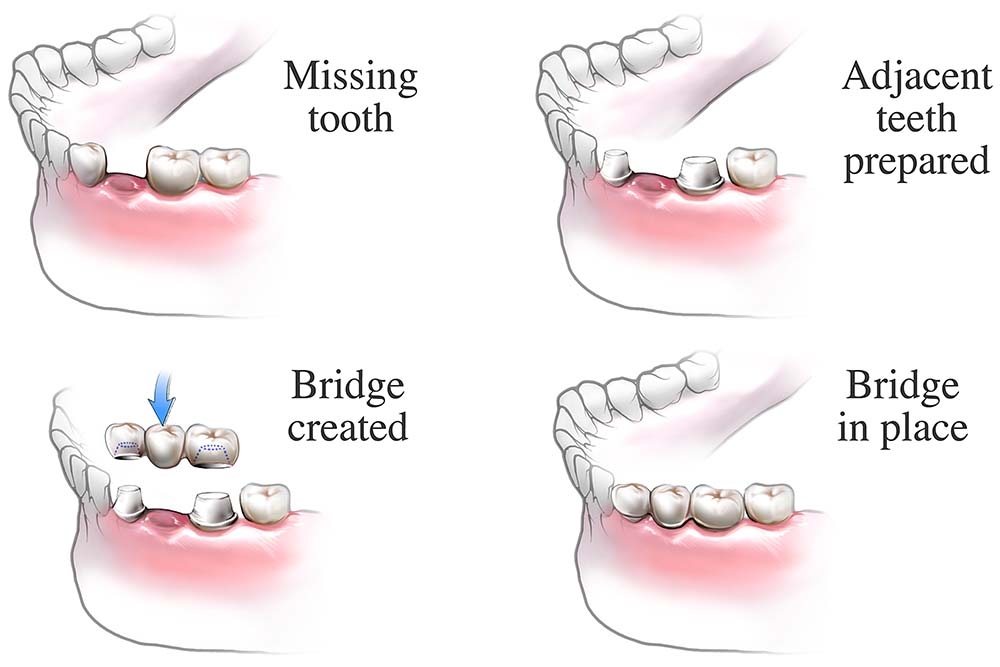Introduction
Are you considering getting dental bridges to restore your smile and improve your oral health? Dental bridges are a popular and effective solution for replacing missing teeth. They can help restore your ability to chew and speak properly, as well as enhance your overall appearance. If you’re unsure about what to expect during the dental bridge procedure, this step-by-step guide will provide you with all the information you need.
Understanding Dental Bridges
Before diving into the step-by-step guide, it’s important to understand what dental bridges are. Dental bridges are prosthetic devices used to replace missing teeth. They consist of one or more artificial teeth, known as pontics, which are held in place by dental crowns on either side.
Initial Consultation
The first step in getting dental bridges is to schedule an initial consultation with your dentist. During this appointment, your dentist will examine your oral health, evaluate the condition of your teeth and gums, and determine if dental bridges are the right solution for you.
X-rays and Impressions
To create a customized dental bridge, your dentist will take X-rays and impressions of your teeth. These images will help in designing a bridge that fits perfectly in your mouth and matches the color and shape of your natural teeth.
Preparing the Abutment Teeth
Once the initial consultation is complete, the next step is to prepare the abutment teeth. These are the teeth on either side of the gap where the dental bridge will be placed. Your dentist will reshape these teeth by removing a small portion of enamel to make room for the dental crowns that will hold the bridge in place.
Temporary Bridge Placement
While your permanent dental bridge is being fabricated in a dental laboratory, your dentist will place a temporary bridge to protect the exposed teeth and gums. This temporary bridge will also help you get accustomed to the feeling of having a dental bridge in your mouth.
Fitting the Permanent Bridge

Once your permanent dental bridge is ready, you will return to your dentist’s office for its placement. Your dentist will remove the temporary bridge and check the fit and appearance of the permanent bridge. Adjustments may be made to ensure a comfortable and natural-looking fit.
Bonding the Bridge
After ensuring the perfect fit, your dentist will bond the dental bridge in place using dental cement. This cement is carefully applied to the abutment teeth.
Summary
Getting dental bridges is a common dental procedure that can greatly improve your oral health and restore your smile. This step-by-step guide will walk you through the entire process, from the initial consultation to the final placement of your dental bridge. By understanding what to expect, you can feel more confident and prepared for your dental bridge procedure.
- Q: What is a dental bridge?
- A: A dental bridge is a fixed dental restoration used to replace one or more missing teeth by joining an artificial tooth to adjacent teeth or dental implants.
- Q: How long does it take to get a dental bridge?
- A: The process of getting a dental bridge typically requires two or more dental visits. The duration may vary depending on individual cases, but it usually takes a few weeks to complete.
- Q: What are the steps involved in getting a dental bridge?
- A: The steps involved in getting a dental bridge include:
- Initial consultation and examination
- Tooth preparation and shaping
- Impression taking
- Temporary bridge placement (if necessary)
- Final bridge placement
- Q: Does getting a dental bridge hurt?
- A: The dental bridge procedure is usually performed under local anesthesia, so you shouldn’t feel any pain during the process. However, some patients may experience mild discomfort or sensitivity after the procedure, which can be managed with over-the-counter pain relievers.
- Q: How long does a dental bridge last?
- A: With proper care and regular dental check-ups, dental bridges can last for 10-15 years or even longer. However, their lifespan may vary depending on individual oral hygiene habits and other factors.
- Q: How do I take care of my dental bridge?
- A: To maintain the longevity of your dental bridge, it is important to:
- Brush your teeth and bridge twice a day with a soft-bristled toothbrush
- Floss daily, including under the bridge
- Visit your dentist regularly for check-ups and professional cleanings
- Avoid chewing on hard or sticky foods that may damage the bridge

Hello, and welcome to my website! My name is Thomas Anderson, and I am thrilled to share my passion for dental hygiene with you. As a professional dental hygienist, I have dedicated my career to helping individuals achieve optimal oral health and maintain beautiful smiles.



